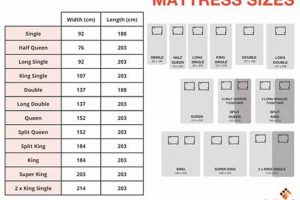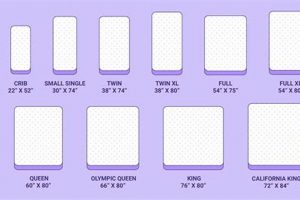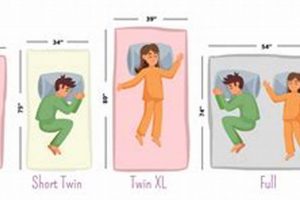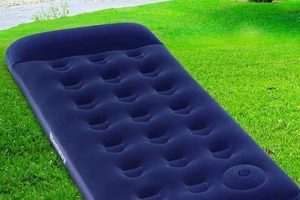A sleeping platform designed to fit within the spatial constraints of recreational vehicles, often RVs or campers, and sized similarly to a standard queen mattress is a critical component for comfort. Its dimensions typically measure around 60 inches wide and 80 inches long, though variations may exist depending on the manufacturer and vehicle layout. For example, some RVs utilize a short queen, measuring 60 inches by 75 inches, to conserve space.
The selection of an appropriately sized sleeping surface is essential for ensuring adequate rest during travel and leisure activities. The availability of a larger sleeping area, compared to smaller RV mattress sizes, can significantly improve sleep quality, particularly for couples. Historically, RV mattresses were often thin and uncomfortable, but modern manufacturing provides enhanced comfort options, increasing the overall enjoyment of the camping experience.
The subsequent sections will delve into the various types of construction materials, considerations for choosing the ideal option, and factors influencing longevity and maintenance of this crucial component within a mobile living space.
Essential Considerations for Recreational Vehicle Bedding Selection
Selecting the appropriate sleeping surface for a recreational vehicle requires careful evaluation. Prioritizing comfort and durability will enhance the travel experience. These guidelines provide key insights for discerning buyers.
Tip 1: Measure Available Space Accurately: Precise measurements of the sleeping area within the recreational vehicle are essential before purchasing. Inaccurate dimensions will result in an ill-fitting and potentially unusable product.
Tip 2: Consider Foam Density and Composition: Higher foam density typically indicates increased durability and support. Evaluate the type of foam, such as memory foam, latex, or a hybrid, based on individual preferences and support requirements.
Tip 3: Evaluate Thickness and Loft: The thickness of the mattress influences comfort and support. Consider the available headroom within the recreational vehicle and the individual’s preferred sleeping position when selecting thickness.
Tip 4: Prioritize Breathability: Enhanced airflow reduces heat retention and improves sleep quality, particularly in warmer climates. Look for mattresses with breathable materials or construction techniques.
Tip 5: Examine Cover Materials: The cover should be durable, easy to clean, and hypoallergenic. Water-resistant covers are beneficial in preventing moisture damage from spills or humidity.
Tip 6: Assess Weight and Portability: The weight of the mattress impacts fuel efficiency. Lightweight materials are advantageous, particularly in smaller recreational vehicles.
Tip 7: Review Warranty and Return Policies: A comprehensive warranty provides assurance of product quality. Understand the terms and conditions of the warranty and return policy prior to purchase.
Selecting an appropriate sleeping surface significantly impacts the overall travel experience. Addressing factors such as measurements, material quality, and warranty will maximize comfort and longevity.
The subsequent section will discuss the maintenance and care required to prolong the life of recreational vehicle bedding.
1. Dimensions
The defining characteristic of a “camper queen size mattress” is its size, specifically its dimensions. These measurements directly dictate whether it will fit within the confines of a recreational vehicle’s sleeping area. Failure to accurately consider dimensions results in a mismatch, rendering the bedding unusable. For instance, a standard queen mattress (60 inches wide by 80 inches long) may be too large for certain RV layouts, necessitating a “short queen” (60 inches by 75 inches) or a custom size. The available space in the RV is, therefore, the primary cause determining the dimensions required for the mattress.
The significance of precise dimensions extends beyond mere fit. An ill-fitting mattress compromises comfort and safety. Excess material can bunch up, creating uneven sleeping surfaces, while a mattress that is too small leaves gaps that could pose tripping hazards. Manufacturers often provide detailed dimension specifications, including length, width, and thickness, to facilitate informed purchasing decisions. Furthermore, accounting for the thickness is vital as it impacts headroom and overall comfort within the confined space. For example, a thicker mattress, while potentially more comfortable, may restrict headroom to an uncomfortable degree.
In summary, the dimensions are a fundamental and non-negotiable aspect of a “camper queen size mattress”. Accurate measurement and adherence to specified dimensions are critical for ensuring compatibility, comfort, and safety within the recreational vehicle. The challenge lies in the variability of RV layouts, necessitating careful attention to dimensional details during the selection process, and emphasizing the need for precise measurements before purchase.
2. Foam Density
Foam density, measured in pounds per cubic foot (lbs/ft), significantly influences the performance and longevity of a “camper queen size mattress.” Higher density foams, typically exceeding 4 lbs/ft for memory foam and 2 lbs/ft for polyurethane foam, provide increased support and resistance to compression. This translates to enhanced durability and reduced sagging over time, particularly crucial in RV applications where weight distribution may be uneven due to varying floor surfaces. The selection of an appropriate foam density directly correlates with the long-term comfort and usable lifespan of the mattress. For example, a low-density foam may initially feel comfortable but will quickly degrade under repeated use, leading to discomfort and requiring premature replacement.
The impact of foam density extends beyond simple durability. Denser foams offer improved motion isolation, minimizing disturbance from a sleeping partner’s movements. This is particularly advantageous in the compact confines of an RV, where space is limited and disturbances are more easily transmitted. Furthermore, higher density foams tend to be more temperature-neutral, mitigating the excessive heat retention often associated with lower-quality memory foams. The consequence of neglecting foam density consideration is frequently manifested in decreased sleep quality, accelerated mattress degradation, and a compromised overall recreational vehicle experience. Choosing a mattress with adequate foam density is thus an investment in sustained comfort and support.
In summary, foam density is a critical determinant of a “camper queen size mattress'” quality, durability, and overall performance. Understanding the relationship between foam density and these factors enables informed decision-making, ultimately contributing to a more comfortable and restful experience within the constraints of a recreational vehicle. The challenge lies in balancing the benefits of higher density with potential cost increases, requiring careful assessment of individual needs and budgetary constraints.
3. Mattress Thickness
Mattress thickness is a critical dimension when selecting a “camper queen size mattress,” influencing comfort, support, and the overall usability of the sleeping space within a recreational vehicle. The appropriate thickness balances comfort needs with spatial limitations, and directly affects headroom and accessibility.
- Headroom and Accessibility
A thicker mattress can significantly reduce headroom within an RV, particularly in overhead bunk areas or smaller travel trailers. Limited headroom creates an uncomfortable and claustrophobic environment. Conversely, a thinner mattress may improve headroom but compromise support and comfort. The choice must carefully balance ergonomic needs with spatial constraints. For instance, a taller individual may require a thinner mattress to maintain adequate headroom, while a side sleeper might need a thicker option for proper spinal alignment.
- Support and Comfort Layers
Thickness directly impacts the layering of materials that contribute to support and comfort. A thicker mattress allows for more substantial comfort layers, such as memory foam or latex, which contour to the body and alleviate pressure points. Insufficient thickness limits these comfort layers, resulting in a firmer and potentially less comfortable sleeping surface. A thicker “camper queen size mattress” can accommodate a more complex internal structure, incorporating support cores, transition layers, and plush top layers. For example, a 12-inch mattress might include a high-density foam base, a transition layer of responsive foam, and a top layer of memory foam for enhanced comfort.
- Weight Considerations
Thickness contributes to the overall weight of the mattress, a critical consideration in RVs where weight management is essential for fuel efficiency and vehicle handling. Thicker mattresses inherently weigh more due to the increased volume of materials. This added weight can impact fuel consumption and potentially exceed weight limits, particularly in smaller travel trailers. Consequently, selecting a “camper queen size mattress” with a moderate thickness, balancing comfort with weight, is vital. For instance, a thinner, lighter mattress made with high-density foam can provide adequate support without adding excessive weight.
- Storage Space Impact
In some RV layouts, the “camper queen size mattress” may need to be lifted or folded to access storage compartments underneath. A thicker mattress makes this process more cumbersome and may restrict access to these storage areas. A thinner, more flexible mattress simplifies storage access and minimizes the effort required to lift or manipulate it. This is particularly relevant in RVs with limited storage capacity, where every inch of available space is valuable. For example, a foldable or hinged mattress design can further enhance storage access, regardless of thickness.
Ultimately, the optimal thickness of a “camper queen size mattress” is a compromise dictated by the specific constraints and priorities of the recreational vehicle owner. It requires balancing comfort, support, weight, storage accessibility, and headroom to achieve the best possible sleeping environment within the limited confines of an RV.
4. Breathability
Breathability, concerning recreational vehicle bedding, directly influences the thermal regulation and moisture management within the sleeping environment. The confined nature of RV interiors necessitates heightened attention to airflow and ventilation to prevent discomfort and promote restful sleep. Thus, breathability is vital when selecting a camper queen-size mattress.
- Material Composition and Airflow
The inherent breathability of mattress materials dictates the rate at which air circulates through the bedding. Open-cell foam structures, such as those found in latex and certain memory foams, facilitate greater airflow compared to closed-cell alternatives. This characteristic minimizes heat retention and allows for the dissipation of moisture, preventing the build-up of humidity that can lead to discomfort and potential mold growth. For example, a latex mattress with pinhole perforations will exhibit superior breathability compared to a solid polyurethane foam mattress.
- Cover Fabric and Ventilation
The mattress cover plays a pivotal role in regulating breathability. Fabrics such as organic cotton, bamboo, and specialized performance textiles promote air circulation and wick away moisture from the body. Tightly woven synthetic fabrics can impede airflow, trapping heat and contributing to a less comfortable sleep experience. As an example, a mattress cover made from breathable bamboo fibers will enhance ventilation compared to a cover made from tightly woven polyester.
- Construction Techniques and Heat Dissipation
Mattress construction techniques influence airflow and heat dissipation. Hybrid mattresses, incorporating coil systems with foam layers, typically offer superior breathability compared to all-foam mattresses. The coil system promotes air circulation, allowing heat to escape more efficiently. Similarly, mattresses with convoluted foam layers or ventilated designs enhance airflow and reduce heat retention. For instance, a hybrid camper queen-size mattress with individually wrapped coils will generally provide better ventilation than a solid memory foam mattress.
- Environmental Conditions and Humidity Control
External environmental conditions significantly impact the importance of breathability. In humid climates, mattresses with enhanced breathability are essential for preventing moisture build-up and maintaining a comfortable sleep environment. Conversely, in drier climates, breathability may be less critical but still contributes to overall thermal regulation. Integrating dehumidifiers or ventilation systems within the RV can further mitigate the effects of high humidity, particularly when using a camper queen-size mattress with moderate breathability.
These facets of breathability highlight its critical role in maintaining a comfortable and hygienic sleeping environment within a recreational vehicle. The selection of a camper queen-size mattress with adequate breathability contributes directly to improved sleep quality and overall well-being, particularly during extended travel and in varying environmental conditions. Failure to address breathability concerns can result in discomfort, moisture accumulation, and potential health hazards, underscoring the importance of informed decision-making when selecting RV bedding.
5. Cover Material
The cover material of a “camper queen size mattress” is not merely an aesthetic component, but a functional layer directly impacting the mattress’s durability, hygiene, and thermal regulation. The choice of material influences resistance to abrasion from transport, protection against spills, and breathability, all critical factors in the challenging environment of a recreational vehicle. For example, a tightly woven polyester cover may offer superior water resistance, preventing liquids from penetrating the foam core and causing mold growth, a common problem in damp RV environments. In contrast, a breathable cotton cover, while less water-resistant, promotes airflow, reducing heat build-up and improving sleep comfort, especially in warmer climates. The consequence of neglecting appropriate cover material is reduced mattress lifespan and compromised sleeping comfort.
The practical significance of understanding cover material properties extends to maintenance and cleaning. A durable, stain-resistant cover simplifies cleaning and reduces the need for frequent professional cleaning or replacement. Covers with zipper closures allow for easy removal and washing, an essential feature in RVs where space is limited and hygiene is paramount. For instance, a microfiber cover can be easily wiped clean, while a more delicate material may require specialized cleaning products and techniques. Furthermore, some covers are treated with antimicrobial agents to inhibit the growth of bacteria and fungi, providing an added layer of protection against allergens and odors. The material should be selected considering the expected use, environmental factors, and maintenance capabilities within the RV.
In summary, the cover material of a “camper queen size mattress” is a key determinant of its performance and longevity within the demanding context of recreational vehicle use. It influences water resistance, breathability, cleanability, and overall hygiene. Selecting an appropriate material, based on anticipated environmental conditions and maintenance capabilities, ensures a more comfortable, durable, and hygienic sleeping environment, minimizing the risks associated with moisture damage and allergen accumulation. The selection process involves carefully balancing competing priorities, such as water resistance versus breathability, to optimize performance under specific RV conditions.
6. Weight
The weight of a “camper queen size mattress” is a critical parameter impacting fuel efficiency, payload capacity, and overall handling of a recreational vehicle. Managing weight is crucial for safe and economical travel.
- Fuel Efficiency and Operating Costs
Increased weight directly translates to higher fuel consumption. A heavier mattress adds to the overall load of the RV, requiring the engine to expend more energy to propel the vehicle. This results in decreased miles per gallon and increased operating costs, particularly over extended travel distances. For example, a difference of 20 pounds in mattress weight, compounded over thousands of miles, can significantly impact fuel expenses. The selection of lightweight materials is thus a key consideration in minimizing fuel consumption.
- Payload Capacity and Safety
Every RV has a designated payload capacity, representing the maximum allowable weight of passengers, cargo, and fluids. Exceeding this limit compromises vehicle stability, braking performance, and tire integrity, increasing the risk of accidents. A heavy “camper queen size mattress” reduces the available payload capacity, potentially forcing difficult choices regarding other essential items. Understanding the RV’s payload capacity and carefully managing weight distribution are paramount for safe operation.
- Handling and Stability
Excessive weight affects the handling and stability of the RV, particularly during cornering and braking. A heavier mattress, especially if located in an elevated bunk area, raises the vehicle’s center of gravity, making it more susceptible to swaying and rollovers. This is especially critical in high-wind conditions or on uneven road surfaces. Distributing weight evenly and minimizing the addition of heavy items, such as excessively dense mattresses, improves vehicle stability and handling.
- Material Composition and Weight Reduction
The materials used in constructing a “camper queen size mattress” significantly influence its weight. Traditional innerspring mattresses are generally heavier than foam mattresses due to the weight of the steel coils. High-density memory foam mattresses can also be heavy, while lighter alternatives include latex foam, open-cell foam, or hybrid designs that combine foam with lightweight coil systems. The selection of lightweight materials, without compromising comfort and support, is crucial for minimizing the overall weight of the mattress.
Therefore, selecting a “camper queen size mattress” involves carefully considering its weight in relation to the RV’s specifications and operational requirements. Balancing comfort and support with weight reduction is essential for maximizing fuel efficiency, maintaining safety, and ensuring optimal handling of the vehicle. Overlooking the weight factor can lead to increased operating costs, compromised safety, and a less enjoyable travel experience.
7. Warranty
The warranty associated with a “camper queen size mattress” is a critical aspect of the purchase, representing the manufacturer’s assurance regarding product quality and durability. A comprehensive warranty mitigates financial risk and provides recourse in the event of defects or premature failure, vital considerations given the stresses of RV use.
- Coverage Scope and Duration
The scope of the warranty dictates the specific defects or issues covered, while the duration defines the period during which the coverage remains valid. Comprehensive warranties typically cover manufacturing defects, sagging exceeding a specified threshold, and issues with seams or materials. Limited warranties may only cover specific components or defects, and shorter durations offer less long-term protection. A “camper queen size mattress” subjected to frequent use and varying environmental conditions benefits from a warranty with broad coverage and extended duration. For example, a 10-year warranty covering sagging exceeding 1.5 inches provides more robust protection than a 1-year warranty limited to manufacturing defects.
- Exclusions and Limitations
Warranty agreements invariably include exclusions and limitations, specifying circumstances under which coverage is voided. Common exclusions include damage caused by misuse, neglect, or improper cleaning, as well as normal wear and tear. Some warranties may also exclude coverage for stains, odors, or damage caused by pets. Understanding these exclusions is crucial for maintaining warranty validity and avoiding unexpected expenses. Using an inappropriate cleaning agent or failing to provide adequate support for the “camper queen size mattress” can invalidate the warranty, leaving the owner responsible for repair or replacement costs.
- Claim Process and Resolution
The ease and efficiency of the warranty claim process are critical considerations. A streamlined claim process minimizes disruption and expedites resolution. Manufacturers with readily accessible customer service and clear instructions for submitting claims demonstrate a commitment to customer satisfaction. The resolution may involve repair, replacement, or a refund, depending on the nature of the defect and the terms of the warranty. A manufacturer that requires extensive documentation or imposes unreasonable delays in processing claims can create frustration and negate the perceived value of the warranty. A straightforward online claim submission process, coupled with prompt communication and a fair resolution, enhances the overall ownership experience.
- Transferability and Resale Value
The transferability of the warranty impacts the resale value of the “camper queen size mattress.” A transferable warranty can be conveyed to a subsequent owner, enhancing the mattress’s attractiveness to potential buyers. Non-transferable warranties expire upon the sale of the RV or mattress, reducing its resale value. Including warranty information in the sales documentation can add perceived value to the transaction.
Ultimately, the warranty associated with a “camper queen size mattress” provides critical protection against unforeseen defects and premature failure. Understanding the scope, exclusions, claim process, and transferability of the warranty enables informed decision-making and minimizes financial risk, leading to a more satisfying recreational vehicle ownership experience. Scrutinizing warranty details is an essential step in selecting a mattress that offers both comfort and long-term value.
Frequently Asked Questions
This section addresses common inquiries regarding camper queen size mattresses, providing concise and informative answers to assist in making informed decisions.
Question 1: What are the standard dimensions of a camper queen size mattress?
A standard camper queen size mattress typically measures 60 inches in width and 80 inches in length. However, variations exist, with “short queen” mattresses measuring 60 inches by 75 inches to accommodate space limitations within specific recreational vehicles.
Question 2: What foam density is recommended for a camper queen size mattress to ensure durability?
For enhanced durability and support, a foam density of at least 4 lbs/ft is recommended for memory foam and 2 lbs/ft for polyurethane foam. Higher densities provide increased resistance to compression and sagging, extending the mattress’s lifespan.
Question 3: How does mattress thickness affect comfort and usability within a recreational vehicle?
Mattress thickness influences headroom, accessibility, and the layering of comfort materials. Balancing thickness with available space is essential to ensure both comfort and usability within the confined environment of a recreational vehicle.
Question 4: Why is breathability an important factor when selecting a camper queen size mattress?
Breathability promotes airflow, regulates temperature, and minimizes moisture build-up, preventing discomfort and potential mold growth. Mattresses with open-cell foam structures and breathable cover fabrics enhance ventilation and improve sleep quality.
Question 5: What cover material is best suited for a camper queen size mattress in a recreational vehicle?
A durable, stain-resistant cover material, such as tightly woven polyester or microfiber, is recommended for protecting the mattress from spills and abrasion. Breathable materials like cotton or bamboo enhance ventilation and improve comfort.
Question 6: How does the weight of a camper queen size mattress affect fuel efficiency and payload capacity?
Mattress weight directly impacts fuel consumption and reduces the available payload capacity of the recreational vehicle. Selecting lightweight materials is crucial for minimizing fuel costs and ensuring safe operation within the vehicle’s weight limits.
Understanding these frequently asked questions provides a solid foundation for selecting a camper queen size mattress that meets individual needs and ensures a comfortable and safe recreational vehicle experience.
The subsequent section will provide a comparative analysis of different types of camper queen size mattresses currently available.
In Conclusion
This exploration has detailed the multifaceted considerations involved in selecting a “camper queen size mattress.” Dimensions, foam density, thickness, breathability, cover material, weight, and warranty were identified as crucial factors influencing comfort, durability, and suitability for recreational vehicle applications. Each element contributes uniquely to the overall performance and longevity of the mattress, impacting the user’s experience and the vehicle’s operational efficiency.
A discerning selection process, informed by the principles outlined herein, is essential for optimizing the sleeping environment within a recreational vehicle. The long-term implications of choosing an appropriate “camper queen size mattress” extend beyond mere comfort, affecting safety, fuel economy, and the overall enjoyment of the mobile living experience. Continued research and technological advancements promise further refinements in mattress design and materials, necessitating ongoing evaluation of available options to ensure optimal performance and value.


![Best Queen Size Floor Mattress [Guide] Organic & Natural Mattress Buyer’s Guide: Non-Toxic Sleep Solutions Best Queen Size Floor Mattress [Guide] | Organic & Natural Mattress Buyer’s Guide: Non-Toxic Sleep Solutions](https://mattressworldpa.com/wp-content/uploads/2025/07/th-2269-300x200.jpg)




![Best Coleman Queen Size Air Mattress [Guide] Organic & Natural Mattress Buyer’s Guide: Non-Toxic Sleep Solutions Best Coleman Queen Size Air Mattress [Guide] | Organic & Natural Mattress Buyer’s Guide: Non-Toxic Sleep Solutions](https://mattressworldpa.com/wp-content/uploads/2025/07/th-2264-300x200.jpg)